Top News

March 23, 2015 Ryukyu Shimpo
Save Iriomote wild cats from traffic accidents – five couples are involved in a project called the “Yamaneko Patrol,” on roads around Taketomi Town, Iriomote Island where many wild cats have been seen. Twenty-nine-year old Mirai Hirai who came back to her hometown three years ago after getting married, has joined the patrols with her family. She hopes the project will be a success, “I only realized how wonderful the island of Iriomote and its wild cats are, after I had lived elsewhere for so long. I hope this project to protect the wild cats will spread across the island.” At 7 p.m., Hirai and her 28-year old husband Noriyuki took off with their two children for a patrol in their mini car covered with stickers reading, “Wild cat” and “Save our wildlife.” On the prefectural road where the speed limit is 40km per hour, they drive along slowly at around 20-30 km per hour with the hazard lamps flashing. They pay close attention to the road and the bushes alongside it, looking for wildlife. At the same time they want to send out a message to other drivers not to break the speed limit.
The patrols began as part of a project by the nonprofit organization Japan Tiger and Elephant Fund (JTEF) four years ago to help conserve the wild cat. Those involved are local residents, like the Hirai family. Initially, the patrols were only done during the summer months but they’ve now been extended throughout the whole year. The group has grown in size and they carry out patrols up to five times a week during the peak season. They also conduct surveys to monitor the speed of vehicles using the roads. Such information is used in their promotional activities.
Hirai, who goes out on patrol once a week, only learned about the high number of traffic accidents involving wild cats when she moved back to Iriomote. She recalls how she was shocked by what was happening, “I knew nothing about it even though I am from the island.” She started volunteering on the project a year and half ago.
The executive director of JTEF, Masayuki Sakamoto, commented, “It is very significant that local residents are actively involved in this project. The participants are really aware of the importance of conservation, and hopefully this will lead to more participation by the younger generation.” Sakamoto is hoping the project will grow further.
Hirai said, “The wild cats are a treasure of our island, but it feels that local people haven’t got serious yet about saving them. It somehow reminds me of myself a long time ago. It was only leaving the island that made me notice that we have so many things we need to protect.” She added forcefully, “I would like to continue the patrols to let more people know what has to be done to protect the wild cats.”
(English translation by T&CT and Sayaka Sakuma)
GO to Japanese
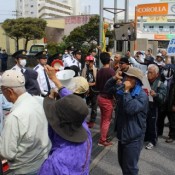
March 31, 2015 Ryukyu Shimpo
A man has been arrested in front of the main gate at Camp Schwab in Henoko. It happened on the morning of March 31. He was part of a protest against construction work at the base and was arrested for obstructing officers in the course of their duty. He was taken to Nago Police Station.
The governments of Japan and the United States are in the process of building a replacement base for the US Marine Corps Air Station Futenma in the Henoko district of Nago.
In the early morning, about 20 citizens staged a sit-in protest in an effort to prevent vehicles carrying Japan Coast Guard (JCG) officers and construction workers from entering the base. At one point, about 100 riot police officers scuffled with the protesters, resulting in the man’s arrest. He was detained in the base before being taken to Nago police station at around 8:50 a.m.
At 11 a.m. about 80 people gathered in front of the police station, calling the man’s arrest unjustified and demanding his release. They also said the police should stop harassing protesters.
In the sea off Henoko, workers employed by the Okinawa Defense Bureau continued work from two marine construction barges. Protesters took to the sea in 18 kayaks. Eight of them were removed by officers of the JCG.
(English translation by T&CT)
Go to Japanese
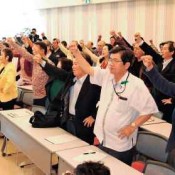
March 29, 2015 Ryukyu Shimpo
About 100 members of Okinawa’s local municipal assemblies and the Diet have set up an organization to work towards blocking construction of a new U.S. base in Henoko, Nago. They have agreed to work together to stop the Futenma relocation plan.
They are planning a sit-in-protest in front of the Camp Schwab to take place in the morning from April 6 to 8. They will take part in a rally of about 10,000 people, which will be held at Okinawa Cellular Stadium, Naha, on May 17.
At a launch gathering held on March 29 in Naha, they adopted a resolution, which says, “The people of Okinawa prefecture have consistently opposed new U.S. base construction. We cannot forgive the Japanese government for its relentless and hardline stance. We will strive to mobilize the energy of the people.”
They will ask other assembly members to take part in the organization, and aim to increase the number of participants to several hundred. House of Representatives lawmakers Kantoku Teruya, Seiken Akamine, Denny Tamaki, Toshinobu Nakazato and Upper House lawmaker Keiko Itokazu became joint representatives of the organization. Satoru Nakasone, chairperson of the ruling party of the prefectural assembly, serves as the secretary-general of the organization.
Nakasone said, “In order to realize our aim to block new U.S. base construction, we want to tie together our common feelings, and work hard as leaders for the people.”
(English translation by T&CT)
Go to Japanese
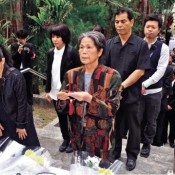
March 27, 2015 Ryukyu Shimpo
On March 26, 1945, U.S. forces landed on the Kerama Islands, beginning the ground war in Okinawa. To mark the seventieth anniversary since that day, the Zamami Village Office held a memorial service at the tower of peace. About 100 people, including survivors and bereaved families of the war dead, attended the service. The participants made a wish for ‘permanent peace and no more war.’ They said they felt a sadness that could not be erased, even 70 years after the end of the war. The memorial service was held for the first time in five years
.
The names of one thousand and two hundred war dead, 647 villagers, including victims of compulsory mass suicide, Japanese military soldiers, civilian personnel, including schoolteachers, and workers from the Korean peninsula have been engraved in the tower.
At the service, Mayor Satoru Miyazato said: “While we must forever endure the pain that can never be healed, people who survived the war have been able to spread the message of the preciousness of peace, as storytellers. Many of them have passed away,” “We should not forget the peace and richness of the island has been built on the painful sacrifice of many war dead and the day-to-day hardships of their family members.”
Fumio Hirata gave a memorial address on behalf of the bereaved family members. Student representatives from the three junior high schools on the island made a peace declaration.
(English translation by T&CT)
Go to Japanese

March 21, 2015 Ryota Shimabukuro of Ryukyu Shimpo reports from Washington D.C.
On March 20, the U.S. National Archives and Records Administration showed an original copy of the Ryukyu-U.S. Treaty of Amity signed by the Ryukyu Kingdom and the United States on July 11, 1854 to the Ryukyu Shimpo. The archive also disclosed a letter written by Commodore Matthew Perry reporting the signing of the Treaty to the States, enclosed together with the original copy. The letter says that Perry was honored to send one of three original copies of the treaty signed with the Ryukyu Kingdom. It seems that Commodore Perry considered the signing a great achievement. The original copy of the treaty, which verified “sovereignty” of the Ryukyu Kingdom, has been carefully stored away at the U.S. National Archives for 160 years after its signing. This highlights the historical value of the treaty.
The original copy of the treaty is stored together with a U.S. Senate ratification document and a proclamation by President Franklin Pierce which are both dated on March 9, 1855.
The letter by Perry was dated on September 5, 1854 and addressed to Navy Secretary James Dobbin.
In all three originals sent to the United States, the letters stated that Perry would bring back one to the states via Europe, and one would be sent with other documents to the states on the U.S. Ship Mississippi.

The original copy of the Ryukyu-U.S. Treaty of Amity kept by U.S. authorities.
The copy kept in the U.S. National Archive is the one that Perry enclosed with his letter. This copy was sent to Secretary of State William Marcy, then held by the State Department and transferred to the National Archives in March 1938. Currently, the treaty is kept in “The Collection of Treaties 194” and is withheld from the public. Meanwhile, the Archives has not confirmed the location of the other two copies. The disclosed copy is the only one from the United States side of which the location is known.
On the Ryukyu side, the Meiji Government confiscated the original copies of the treaty signed with the United States, and also treaties signed with France, in 1855, and the Netherlands, in 1974. Currently, they are in the possession of the Ministry of Foreign Affairs. These three original treaties were temporarily released for display at “the Okinawa Special Exhibition: the Ryukyu, the End of Edo, and the Meiji Restoration” at the Urasoe City Museum until March 29.
(English translation by T&CT and Megumi Chibana)
Go to Japanese
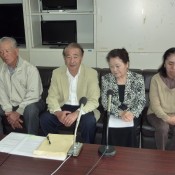
March 26, 2015 Ryukyu Shimpo
Zenzi Nina, the head of the Teima district of Nago, and Fujiko Matsuda, president of the Association of Residents of the Districts North of Futami Opposed to the Construction of a New Base at Henoko, Oura Bay, held a press conference at the correspondents club at the Okinawa Prefectural Government office on March 26. They announced that they have sent documents to three United Nations organizations opposing the relocation of U.S. Marine Corps Air Station Futenma to Henoko, Nago.
The Nago citizens sent the documents to the Office for Disarmament Affairs, the Human Rights Council, and the Environment Programme. The documents state that the governments of Japan and the United States are ignoring Okinawan people’s opposition and forcing through building a new U.S. military base, which could lead to environmental destruction of local communities and ecosystems.
Nina said, “We originally thought the governments of Japan and the United States would give up the construction through negotiations. However, they will not. So, we have had no choice but to ask the UN to work on the issue.”
They said they have sent the documents, written in English, to the UN through fax, e-mail, and mail.
(English translation by T&CT)
Go to Japanese

March 31, 2015 Ryukyu Shimpo
Okinawa Governor Takeshi Onaga urged the Okinawa Defense Bureau to halt offshore construction activity towards the relocation of U.S. Marine Corps Air Station Futenma to the Henoko district of Nago. This includes an order to stop the marine boring survey. However, Fisheries minister Yoshimasa Hayashi suspended the order by the governor on March 30. A representative of the Okinawa Defense Bureau claimed that halting the work could have a negative effect on U.S.-Japan relations, harming diplomacy and the defense of Japan. The Ministry of Agriculture, Forestry and Fisheries of Japan has supported the claim.
Governor Onaga said, “While one sector of the Japanese government asked to overrule the order from the Okinawa Prefectural Government (OPG), another sector of the Japanese government wanted to support it. I think that the judgement is far from fair. It is really a shame.” On the Japanese government’s suspension of his order, Onaga said, “We are now discussing a way forward with experts.”
The timing of Onaga’s decision to cancel the approval of rock reef destruction will be a focal point of his legal strategy.
Onaga announced to the press that he would continue to work on stopping the relocation.
Hayashi said, “I made the judgement after comparing claims made by the OPG and the defense bureau.”

At the Okinawa Prefectural Government office on the afternoon of March 30, Okinawa Governor Takeshi Onaga criticized the minister's suspension order for being unfair.
The minister says he sees the claim made by the bureau as “legitimate” because the Japanese government is equivalent to a private company in charge of carrying out the reclamation, based on the approval of rock reef destruction by the former Okinawa Govenor. Hayashi added, “If the Japanese government overrules the order by the OPG to halt the reclamation work, the suspension will not have a huge influence on common welfare.”
After reviewing the claim from the OPG, the minister will hear the counterargument from the bureau after April 23, and then he will make a final decision.
Following the suspension of his order on March 30, Onaga said, “Siding with Okinawan people, I will prepare however I can to deal with the situation.” He showed his intention to work on countermeasures such as canceling the prefectural government’s approval of rock reef destruction.
(English translation by T&CT)
Go to Japanese
March 25 2015 Ryukyu Shimpo
Okinawa Governor Takeshi Onaga is considering visiting China as one of delegates of the Association for the Promotion of International Trade Japan, in the middle of April. The association’s members plan to meet senior officials of the Chinese government. Onaga aims to promote economic exchanges between Okinawa and China in the fields of logistics and tourism. He wants to realize his economic policy of focusing on Asia, which was one of the major platforms of his election campaign. In 2013, then Okinawa vice-governor Kurayoshi Takara took part in a delegate group to China. This is the first time an Okinawan Governor has taken part. There are about 70 delegate members, most of whom are representatives of major companies in Japan.
The delegates plan to visit Beijing and Xian from April 12 to 17. The delegation will consist of Onaga, Moritake Tomikawa, the head of Okinawa Asia Economic Strategy Plan (OAESP) Committee, and other members of the OAESP committee, and Okinawan companies from the Ryukyu Economic Strategy Study Association.
The association’s delegate members have previously met Wen Jiabao, then Premier of the State Council of the People’s Republic of China in 2011, then Vice-President Xi Jinping in 2012, and Wang Yang, Vice Premier of China in 2013 and 2014.
The participants from Okinawa will stay in China from April 12 to 14. They plan to meet officials of China’s commercial department, and take part in conferences on the latest Chinese economic data and policy. The Okinawan delegate members will also interact with members of societies of commerce and industry in China.
A spokesperson for the Okinawa Prefectural Government (OPG) said, “We would like to take this opportunity to promote economic exchanges between Okinawa and China. We hope companies use special economic zones in China and Okinawa to trade with each other.”
Hong Kong and Taiwan are the main importers of Okinawan products. The OPG wants China to import more Okinawan products. Tomikawa of the OAESP committee said, “To promote business with China, creating a network between officials in the OPG and the Chinese government is important.”
(English translation by T&CT)
Go to Japanese
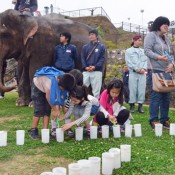
March 19, 2015 Ryukyu Shimpo
On March 17, two elephants that spent the winter season at the Okinawa Zoo and Museum in Okinawa City went back to Fukushima.
A farewell party for them was held on March 15 at the zoo.
The two Asian elephants, Tonsai and Boonthong, came to Okinawa in December from the Tohoku Safari Park in Fukushima. Nobushige Kumakubo, president of the Tohoku Safari Park, said, “We want to continue a family relationship between Okinawa and Fukushima through the elephant support project.”
During their stay for three and half a months in Okinawa, the elephants lived healthily. They had a big appetite and ate sugar cane willingly. Genwa Higa, the curator of the Okinawa Zoo and Museum, said, “We thank them for their many interactions with children in Okinawa.”
Children enjoyed their last elephant ride at the party. They gave cakes to Tonsai and Boonthong, and said in unison to the elephants, “Come back soon!”
(English translation by T&CT, Hitomi Shinzato)
Go to Japanese
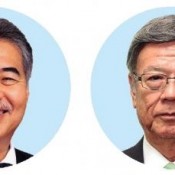
March 18, 2015 Ryukyu Shimpo
On March 17, Okinawa Governor Takeshi Onaga expressed his intention to take part in the 30th anniversary ceremony of a sister-state affiliation between Okinawa and Hawaii. The ceremony will be held in Honolulu in July. Onaga stated, “I would like to participate and exchange opinions with Hawaii State Governor David Ige.” On that day, Onaga met and talked with President Mark Higa of the Hawaii United Okinawa Association (HUOA). According to the HUOA, a delegate group from Hawaii, including Governor David Ige will visit Okinawa in October. It will be the first time Ige has visited Okinawa.
HUOA has been working on a construction plan for commercial facility Hawaii Okinawa Plaza. The revenue from the Plaza will be used for the management expense of HUOA’s operating base Hawaii Okinawa Center. HUOA is calling for Okinawans to donate towards the construction.
Onaga talked about the history of Okinawan immigrants in Hawaii and past exchanges. He said, “Every time I go to Hawaii, I feel the power of Uchinanchu. I would like to cherish the relationship of the prefecture and the State and support it.”
Thirtieth anniversary events will be held from July 9 to 12, and a ceremony will be carried out on the 11th.
(English translation by T&CT and Megumi Chibana)
Go to Japanese
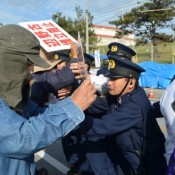
March 24, 2015 Ryukyu Shimpo
The Okinawa Defense Bureau is continuing its boring survey as part of the plan to build a replacement facility for U.S. Marine Corps Air Station Futenma in Henoko, Nago. On March 24, off the coast of Henoko, workers employed by the bureau were carrying out work from two spud barges. On March 23, Okinawa Governor Takeshi Onaga ordered the Japanese Government to halt offshore construction activity, including the marine boring survey, by March 30. Ignoring the governor’s authority, the defense bureau continued the work on March 24.
In front of Camp Schwab gate, citizens raised their voices: “Stop construction,” “We will never allow the work to be carried out forcibly.” A scuffle broke out between riot police and protesters who surrounded a defense bureau’s vehicle that exited the gate. On the sea, the citizen protested against the construction work from ships and canoes.
Hiroji Yamashiro, the director of the Okinawa Peace Movement Center, said, “If the Japanese Government continues offshore work after March 30, we will request that the Okinawa Prefectural Government forces the Japanese Government to stop its work, using the governor’s authority to call out the prefecture police officers.”
(English translation by T&CT)
Go to Japanese












 Webcam(Kokusai Street)
Webcam(Kokusai Street)


